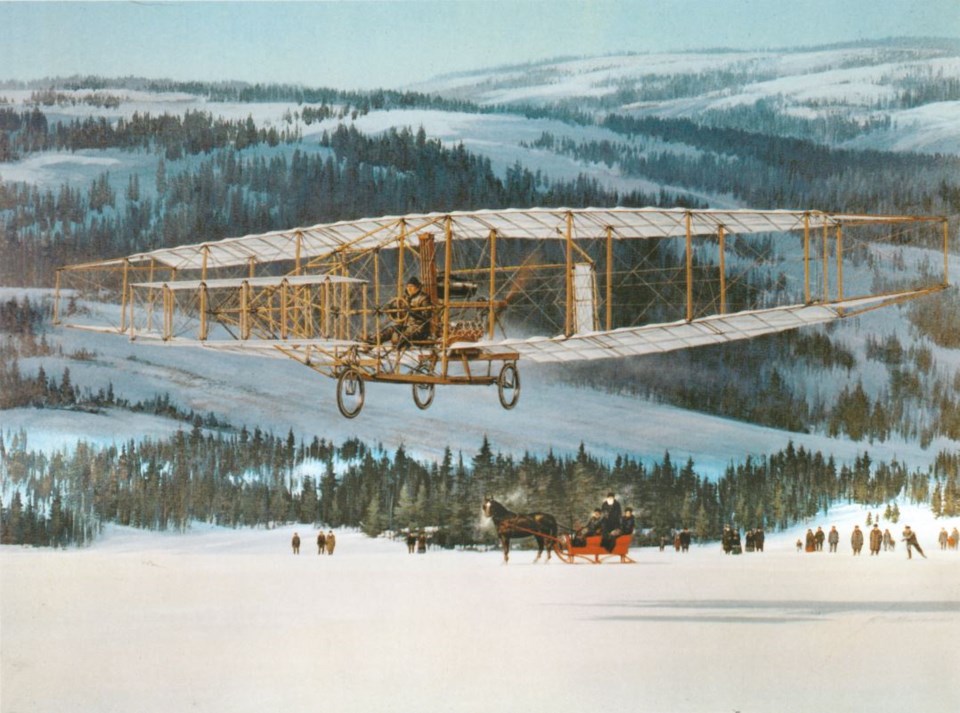The Saskatchewan Air Show returns to Moose Jaw this weekend. It will be the first air show at 15 Wing since 2005. To celebrate, this week we look at aviation history in Canada, with a particular focus on local events.
Canadian Aviation Milestones
Below is a look at 10 early milestones in Canadian aviation history.
- February 23, 1909: the “Silver Dart,” the first powered aircraft to fly in Canada, takes off from a frozen lake at Baddeck, Nova Scotia.
- May 19, 1911: the first powered flight in Saskatchewan.
- July 31, 1913: Alys McKey Bryant becomes the first woman to fly a plane in Canada.
- February 18, 1920: authorization of the Canadian Air Force.
- October 7–17, 1920: first trans-Canada flight.
- March 13, 1928: Eileen Vollick becomes the first Canadian women to receive her pilot’s licence.
- October 9–10, 1930: J. Errol Boyd becomes the first Canadian to make a transatlantic flight.
- December 17, 1939: an agreement is signed that creates the British Commonwealth Air Training Plan.
Famous Pilots
Canada has had plenty of famous aviators over the years. In fact, there are too many to list here.
The list includes early pioneers like John Alexander Douglas McCurdy, who created the Curtis Aeroplane and Motor Company in 1908. He was the first British subject to fly an aircraft in the British Empire when he piloted the Silver Dart. He also founded the first aviation school in Canada.
Of course, there are also famous aces like Billy Bishop and Roy Brown. Bishop is said to have 74 confirmed kills during WWI. He was inducted into the International Air and Space Hall of Fame in 1967. A play about his life has become a classic of Canadian theatre. Meanwhile, Roy Brown is renowned for supposedly being the pilot who took down Manfred von Richthofen, otherwise known as “The Red Baron.” Historians now dispute this achievement, however. As well, some claim Bishop’s record is not entirely accurate either. Regardless, both men are among Canada’s best-known pilots.
Another famous WWI ace was William G. Barker. A Victoria Cross recipient, he is the most decorated serviceman in Canadian history.
The aviation industry has also given us famous astronauts like Mac Garneau, Roberta Bondar and, of course, Chris Hadfield.
Famous women include Violet Milstead Warren, who was the first female Canadian bush pilot. She was also one of just four Canadian women to work in the British Air Transport Auxiliary during WWII. Then there is Rosella Bjornson, who was the first female pilot of a commercial airline in North America.
Finally, there is Maryse Carmichael. She became the first woman to fly with the Snowbirds and later became the first woman to lead the team.
Early Flight in Moose Jaw
Perhaps the first person to fly over the Friendly City was known other than Katherine Stinson, the famous American pilot. Stinson travelled across the country as a barnstormer. She came to Moose Jaw to perform at the fair in August of 1918. A massive crowd came out to watch Stinson’s performance.
According to late historian Leith Knight, Moose Jaw enjoyed its first real “air show” over the course of a week in August of 1921. That is when aerial daredevil Bobby Simpson came to the city for a series of performances. Simpson, known as “The Human Fly,” performed for crowds by completing stunts on the roofs and flagpoles of the city’s tallest buildings. He also rode over the city while sitting on the wheel axle of a plane.
In the 1930s some local doctors used airplanes to meet with patients. In particular, on January 29, 1930 Dr. J.E. Bloomer flew 13 miles northwest to the scene of an emergency. Without the aid of the Moose Jaw Flying Club, Dr. Bloomer would not have been able to make the call, because all roads were unpassable at the time.
Indeed, the Moose Jaw Flying Club was quite the organization in its heyday. The club formed in 1928 and featured two de Havilland Moth planes — one named after Robin Hood flour and another after White Cap beer. Many pilots were trained by the Moose Jaw Flying Club.
1954 Plane Crash
On Thursday, April 8, 1954, there was a mid-air collision above Moose Jaw; a Trans-Canada Air Lines North Star passenger plane collided with an RCAF Harvard trainer.
Thirty-seven people died, including 31 passengers, RCAF pilot Thomas Andrew Thorrat, four TCA crew members, and one Moose Jaw resident. Wreckage from the crash was spread across a three-mile radius. The fuselage crashed into a house at 1324 Third Ave. NE.
Fortunately, the wreckage narrowly missed Ross School.
At the time, it was the site of the worst aviation accident in Canadian history.
Avro Arrow
In the early 1950s, Canada was looking to develop new aircraft. The Avro Arrow was meant to be a supersonic interceptor jet capable of speeds of up to Mach 2.
Featuring an impressive design, it helped establish Canada as a world leader in aeronautics. Although initial tests seemed promising — during its first flight the Arrow broke several speed records — the project never really got off the ground. Part of the problem is the Arrow was unveiled on the same day the Soviet Union launched Sputnik I. Suddenly, all eyes were on outer space.
By 1959, Prime Minister John Diefenbaker ordered everything shut down. Thousands of people lost their job as a result. Prototypes and blueprints were destroyed. For some, ending the Avro Arrow project remains a controversial decision.
You may remember a Canadian Heritage Minute about the Avro Arrow or a 1997 CBC miniseries starring Dan Akroyd.




